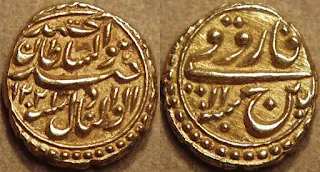Tipu Sultan, also known as the Tiger of Mysore, was a formidable ruler in 18th-century India, and his coins bear witness to the rich history of his reign. These coins, predominantly silver, feature intricate designs reflecting the artistic and cultural vibrancy of the Mysorean era. Many depict Tipu Sultan on the obverse, showcasing his distinctive attire and regal stance, while the reverse often displays symbols and inscriptions of his kingdom.
The coinage of Tipu Sultan is not merely a numismatic artifact; it's a historical testament to his resistance against colonial forces. His coins carry inscriptions in Persian, Arabic, and Kannada, emphasizing the cultural diversity of his kingdom.
Tipu Sultan (1782-1799) Gold pagoda, Nagar, AH 1199, RY 3
Weight: 3.42 gm. Diameter: 12 mm Die axis: 1 o'clock
Persian letter He (for Haidar Ali, Tipu's father), along with mint name Nagar and numeral 3 (regnal year) Legend, including AH date 1199 (= 1785-86 CE)
Reference: KM 109
In the first few years of his reign, Tipu Sultan used the AH date on his
coins, later transitioning to the AM dates (Mauludi era) starting from
regnal year 5. The early coins also maintained the tradition of
featuring the letter 'He,' a practice initiated by his father Haidar Ali
on his coins.
Tipu Sultan (1782-1799) Gold pagoda, Patan, AH 1198, RY 1
Weight: 3.40 gm. Diameter: 12 mm Die axis: 5 o'clock
Persian letter He (for Haidar Ali, Tipu's father), along with numeral 1 (regnal year)
Legend, including AH date 1198 (= 1782 CE) and mint Patan (for Srirangapatnam, or Seringapatan)
Reference: KM --- (unlisted date combination)
A coin from the earliest part of Tipu's reign reflects the continuation
of the practice of placing the letter 'He' on his coins and dating them
in the AH era. In the Krause Mishler (KM) catalog, a coin from Patan is
listed for AH 1198 and regnal year 2. Notably, the combination of AH
1198 and RY 1 is not listed in KM.
Tipu Sultan (1782-1799) Gold pagoda, Patan, AH 1200, RY 4
Weight: 3.44 gm. Diameter: 12 mm Die axis: 4 o'clock
Mint name Patan combined with Persian letter He (for Haidar Ali), along with numeral 4 (regnal year)
Legend, including AH date 1200 (= 1786 CE)
Reference: KM --- (unlisted)
This coin is truly intriguing and clever! In the initial years of Tipu Sultan's reign, he imprinted the AH date on his coins, later transitioning to the AM dates (Mauludi era) in regnal year 5. The early coins also adhered to the tradition of featuring the letter 'He,' as initiated by his father Haidar Ali. This particular coin represents a transitional phase, where the mint name 'Patan' is placed on the obverse. Notably, the last letter of 'Patan' has been modified to resemble the 'He' seen on earlier coins.
Moreover, the numeral '4' denoting the regnal year cleverly replaces the dot that would typically appear in that position within the word 'Patan.' Intriguingly, this unique coin is not listed in the Krause Mishler (KM) catalog.
Tipu Sultan (1782-1799) Gold pagoda, Patan, AM 1221
Weight: 3.43 gm. Diameter: 12 mm Die axis: 1 o'clock
Legend, including AM date 1221 (= 1792 CE)
Legend, including mint Patan (for Srirangapatnam, or Seringapatan)
Reference: KM 129
This coin is dated in the Mauludi era, established by Tipu in regnal
year 5. While the AH date is based on the year of the Hijra, marking the
migration of the Prophet to Medina in 622 CE, the Mauludi era uses as
its base the year of the Prophet's birth in 570/571 CE. Adding to the
complexity, the Hijri calendar is a pure lunar calendar with a year of
only 354 or 355 days, whereas the Mauludi calendar is a lunar-solar one,
featuring a year with 365 days.
Tipu Sultan (1782-1799) AE 2-Paisa, Patan, undated
Weight: 23.32 gm. Diameter: 33 mm Die axis: o'clock
Elephant right with raised trunk, flag and legend above
Legend, including mint Patan (for Srirangapatnam, or Seringapatan)
Reference: KM 124.3 var
The copper double paisas of Tipu are attractive coins highly sought after by collectors.
Tipu Sultan (1782-1799) AE 2-Paisa, Patan, AM 1225
Weight: 21.03 gm. Diameter: 35 mm Die axis: 1 o'clock
Caparisoned elephant walking right, flag with Persian "Be" above
Persian legend stating date, AM 1225 (=1796 CE), and mint Patan
Reference: KM 124.7 var
Tipu Sultan (1782-1799) AE Paisa, Farrukhyab-Hisar, AM 1217
Weight: 11.31 gm. Diameter: 23 mm Die axis: 12 o'clock
Caparisoned elephant walking left, AM date 1217 (=1788 CE) above
Persian legend stating mint Farrukhyab-Hisar (Chitaldurg)
Reference: KM 63.1
Tipu Sultan (1782-1799) AE Paisa, Nagar, AM 1226
Weight: 11.26 gm. Diameter: 23 mm Die axis: 12 o'clock
Caparisoned elephant walking right, Persian letter Te above
Persian legend stating mint Nagar and AM date 1226 (=1797 CE)
Reference: KM 103.8
Tipu Sultan (1782-1799) AE Paisa, Patan, AM 1222
Weight: 11.14 gm. Diameter: 23 mm Die axis: 12 o'clock
Caparisoned elephant walking right, Persian legend and AM date 1222 (=1793 CE) above
Persian legend stating mint Patan
Reference: KM 123.5
In conclusion, Tipu Sultan's coins are more than just monetary
instruments. They are tangible relics that encapsulate the spirit of a
ruler who fiercely defended his kingdom. Owning these coins provides a
glimpse into the past, inviting enthusiasts and collectors to connect
with the valor and cultural richness of Tipu Sultan's era.












Comments
Post a Comment